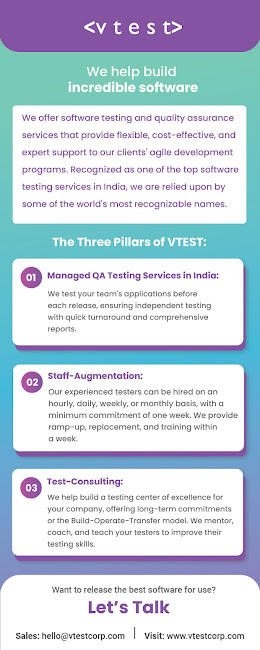Essential for successful functional test automation
Test automation is just
the act of utilizing programming to test programming. A computerized experiment
comprises a progression of orders that execute the means or steps of a test,
just as any information required for the test and the normal outcome. For example,
rather than an individual physically testing a login interaction by entering a
progression of usernames and passwords, an automated experiment presents the
usernames and passwords to the application under test (AUT), looks at the
normal outcomes to the actual outcomes to decide if the test passed or failed,
and makes a report summing up the aftereffects of the test. Mechanization is
ideal for experiments that will be run on numerous occasions.
Listed below are the 6 factors which are
essential to follow for successful functional test automation:
1. Build a team
It would be disastrous to get the manual
testing team to work on test automation tasks. The process and strategy for both are totally
different, and even the results expected would differ. Test automation is a
dedicated and focused activity to consider, and cannot be mixed. So, it is
important to bring a dedicated team on board for the same.
2. Select the tool
There are some key
factors to consider while selecting the automation tool - the underlying objective and the training
involved. It is important to select a tool that is compatible with the
organization and the people who would be involved in the process.
3.
Find the right tool
Yes, selecting the right tool is absolutely
critical and definitely a good start. However, that doesn’t end the job. The
tool cannot be implemented everywhere, as it might not cover every scenario.
But if blended with the right strategy and skill sets, the tool will provide
the expected results.
4. Blend every aspect together for good results
Again, it is critical to keep the objective in
focus while building the automation strategy. It is advisable to begin the
automation process by creating the test case in a manual format - collect all
the requirements and testing data to build the automation plan.
5. Know your software or application
This could be the most important step to
consider, understand the application at hand, and knowing the key features of
the application. This will help implement the tool effectively and enable the
right third-party integrations. This will ensure effective automation even in
the future.
6. Automation cannot be done for everything
While automation can solve major critical issues, it cannot be a solution for all. So, it’s a misconception that if you select the right tool you can automate anything. Automation tools can just make the process easier and faster. You will have to loop in and recruit the right processes that can meet the desired goals Read more(...)

Comments
Post a Comment